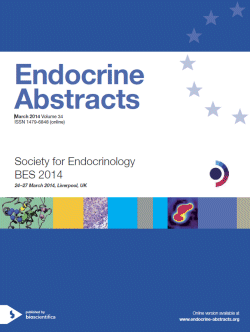Searchable abstracts of presentations at key conferences in endocrinology
Clinical Management Workshops
Workshop 4 (Supported by <emphasis role="italic">Endocrinology, Diabetes & Metabolism Case Reports</emphasis>) Cardiovascular risk in endocrine disease
ea0034cmw4.1 | Workshop 4 (Supported by <emphasis role="italic">Endocrinology, Diabetes & Metabolism Case Reports</emphasis>) Cardiovascular risk in endocrine disease | SFEBES2014
Cardiovascular risk in Turner’s syndrome
The cardiac problems encountered in girls and women with Turners syndrome include: congenital anomalies such as biscuspid aortic valve (30%) which is a risk factor for aortic stenosis and for future aortic rupture, coarctation of the aorta (12%), persistent left superior vena cava (13%) and partial anomalous pulmonary venous return (13%); a tendency towards hypertension (seen in 25% of adolescents) which appears essential in nature and which is not correlated with altera...
ea0034cmw4.2 | Workshop 4 (Supported by <emphasis role="italic">Endocrinology, Diabetes & Metabolism Case Reports</emphasis>) Cardiovascular risk in endocrine disease | SFEBES2014
Valvular disease in prolactinomas: weighing up the evidence
Concern exists in the literature that the long-term use of ergot-derived dopamine agonists (DAs) may be associated with the development of clinically-significant cardiac valvulopathy. This has arisen largely by extrapolation from experience with high doses of these drugs given to patients with degenerative neurological conditions and it has led to regulatory authority recommendations to arrange regular screening echocardiograms for patients receiving much lower doses of these ...
ea0034cmw4.3 | Workshop 4 (Supported by <emphasis role="italic">Endocrinology, Diabetes & Metabolism Case Reports</emphasis>) Cardiovascular risk in endocrine disease | SFEBES2014
Cardiovascular risk in childhood cancer survivors
Advances in childhood cancer treatment have led to an overall 5 year survival rate of almost 80%. As a result 1 in 900 adults are now childhood cancer survivors but have increased risk of long-term health consequences. Data from the USA, UK, and Europe have demonstrated a standardised mortality rate of 8.410.8. Cardiovascular morbidity (congestive heart failure, myocardial infarction, and strokes) have been reported as the commonest non-neoplastic causes of mortality, wi...




